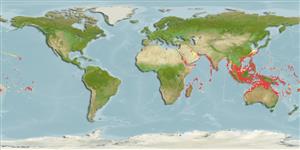Élasmobranches (requins et raies) (sharks and rays) >
Carcharhiniformes (Ground sharks) >
Carcharhinidae (Requiem sharks)
Etymology: Negaprion: negatus (L.), to deny; prion (Gr.), saw, referring to lack of saw-like serrations on teeth cusps. (See ETYFish); acutidens: acutus (L.), sharp or pointed; dens, from dentis (L.), tooth, probably referring to pyramid-like teeth (“dünnen spitzen Pyramiden”). (See ETYFish).
More on author: Rüppell.
Environment: milieu / climate zone / depth range / distribution range
Écologie
marin; saumâtre récifal; profondeur 0 - 92 m (Ref. 244). Tropical; 30°N - 32°S, 32°E - 140°W (Ref. 244)
Indo-Pacific: Red Sea and South Africa (including Mauritius, Seychelles, Madagascar) to Philippines, north to Viet Nam, south to Australia. Also from Palau, Marshall Islands, and Tahiti. Recorded from Taiwan (Ref. 4868).
Length at first maturity / Taille / Poids / Âge
Maturity: Lm 230.0, range 220 - 240 cm
Max length : 380 cm TL mâle / non sexé; (Ref. 5213)
Épines dorsales (Total): 0; Rayons mous dorsaux (Total): 0; Épines anales 0; Rayons mous anaux: 0. A large, stocky, yellowish shark with a broad, blunt snout, narrow, smooth-cusped teeth in both jaws, and equal-sized dorsal fins (Ref. 5578). Yellowish brown above, paler below (Ref. 9997). With two nearly equally large dorsal fins (Ref. 37816).
Found on continental and insular shelves and terraces (Ref. 244). Common on coral reefs (Ref. 5578) and in shallow, sandy lagoons and turbid, mangrove swamps (Ref. 6871). Feeds on smaller sharks, stingrays and on benthic bony fishes (Ref. 5578). Viviparous (Ref. 50449). Dangerous if provoked (Ref. 244). 1 to 11 of 45 cm young are born per litter (Ref. 1602). Meat is utilized fresh and dried salted for human consumption, fins for shark-fin soup base, and liver oil for vitamins (Ref. 244).
Viviparous, placental (Ref. 50449), 1-14 per litter (Ref. 6871). Gestation period 10-11 months (Ref. 5578; Ref.58048). Size at birth about 50 to 70 cm TL (Ref. 9997); 45-80 cm TL (Ref.58048). Distinct pairing with embrace (Ref. 205). Mating and pupping take place during late spring and early summer (Ref. 37816).
Compagno, L.J.V., 1984. FAO Species Catalogue. Vol. 4. Sharks of the world. An annotated and illustrated catalogue of shark species known to date. Part 2 - Carcharhiniformes. FAO Fish. Synop. 125(4/2):251-655. Rome: FAO. (Ref. 244)
Statut dans la liste rouge de l'IUCN (Ref. 130435)
Utilisations par l'homme
Pêcheries: commercial
Plus d'informations
RéférencesAquacultureProfil d'aquacultureSouchesGénétiqueElectrophoresesHéritabilitéPathologiesTraitementNutrientsMass conversion
Outils
Articles particuliers
Télécharger en XML
Sources Internet
Estimates based on models
Preferred temperature (Ref.
123201): 24.7 - 29.1, mean 28.1 °C (based on 2034 cells).
Phylogenetic diversity index (Ref.
82804): PD
50 = 0.7500 [Uniqueness, from 0.5 = low to 2.0 = high].
Bayesian length-weight: a=0.00468 (0.00218 - 0.01003), b=3.09 (2.92 - 3.26), in cm total length, based on LWR estimates for this (Sub)family-body shape (Ref.
93245).
Niveau trophique (Ref.
69278): 4.1 ±0.6 se; based on diet studies.
Résilience (Ref.
120179): Très faible, temps minimum de doublement de population supérieur à 14 ans (Fec=1).
Fishing Vulnerability (Ref.
59153): Very high vulnerability (90 of 100).
Nutrients (Ref.
124155): Calcium = 4.33 [0.92, 24.01] mg/100g; Iron = 0.333 [0.079, 0.955] mg/100g; Protein = 21.8 [19.4, 24.0] %; Omega3 = 0.0965 [, ] g/100g; Selenium = 36.1 [10.5, 103.9] μg/100g; VitaminA = 35.2 [11.3, 117.2] μg/100g; Zinc = 0.6 [0.3, 1.2] mg/100g (wet weight);
